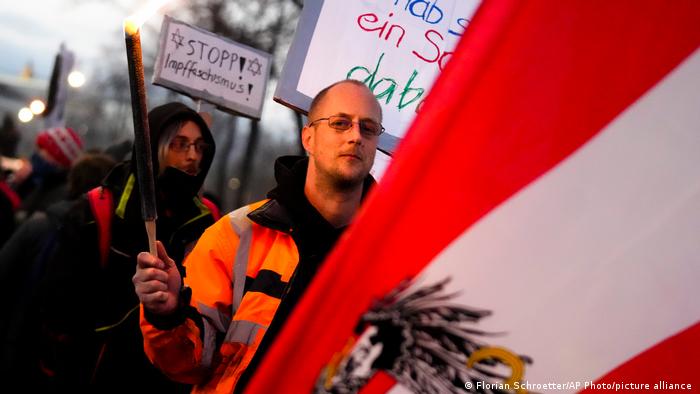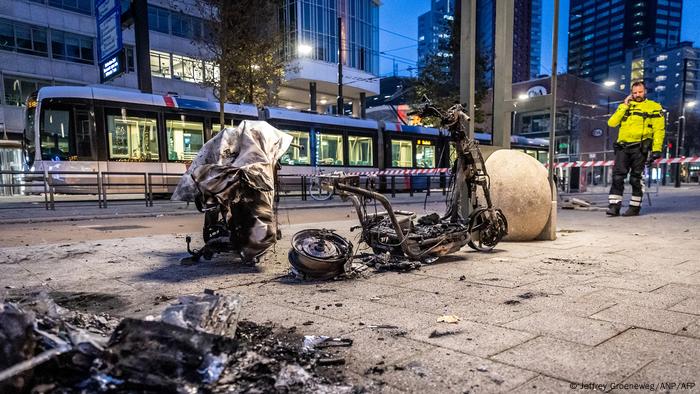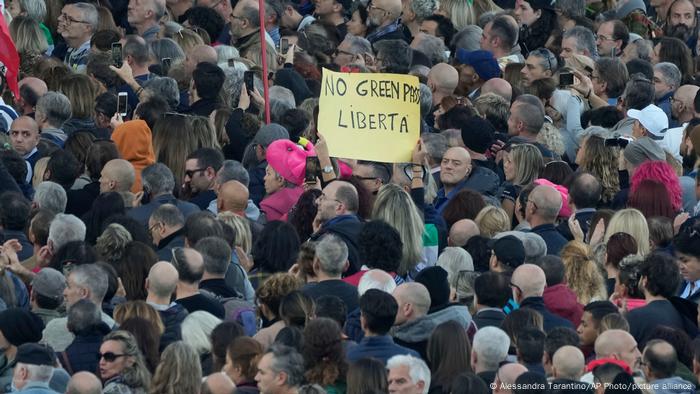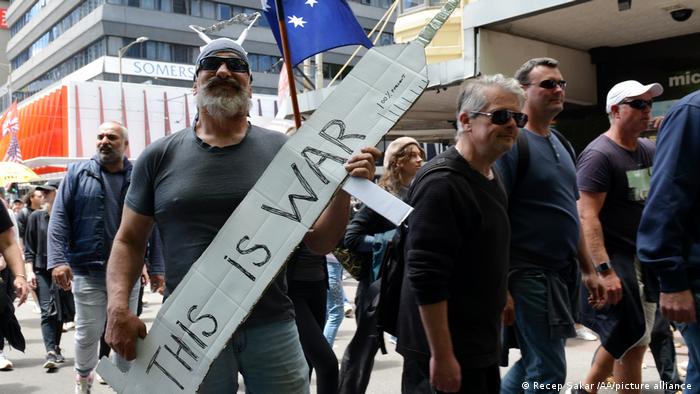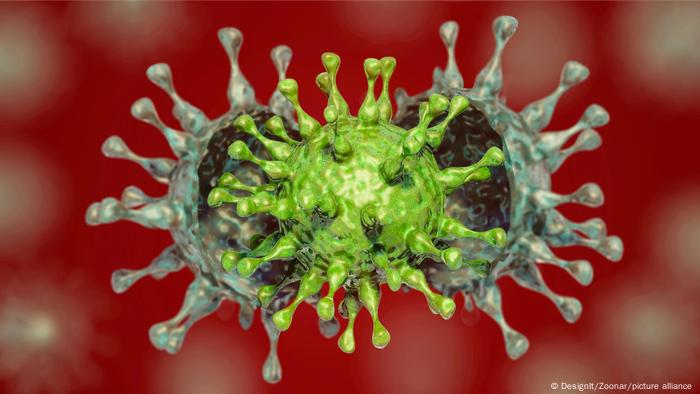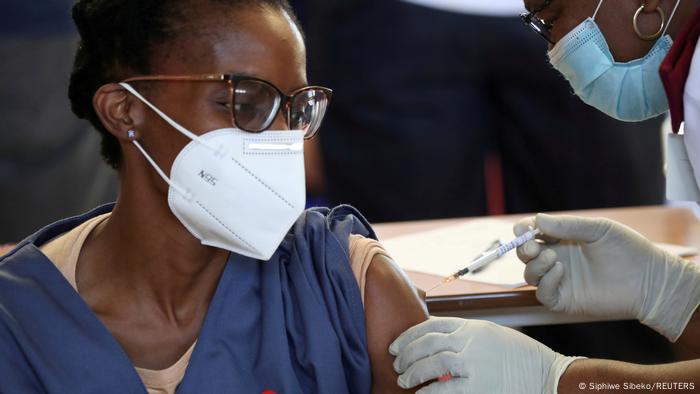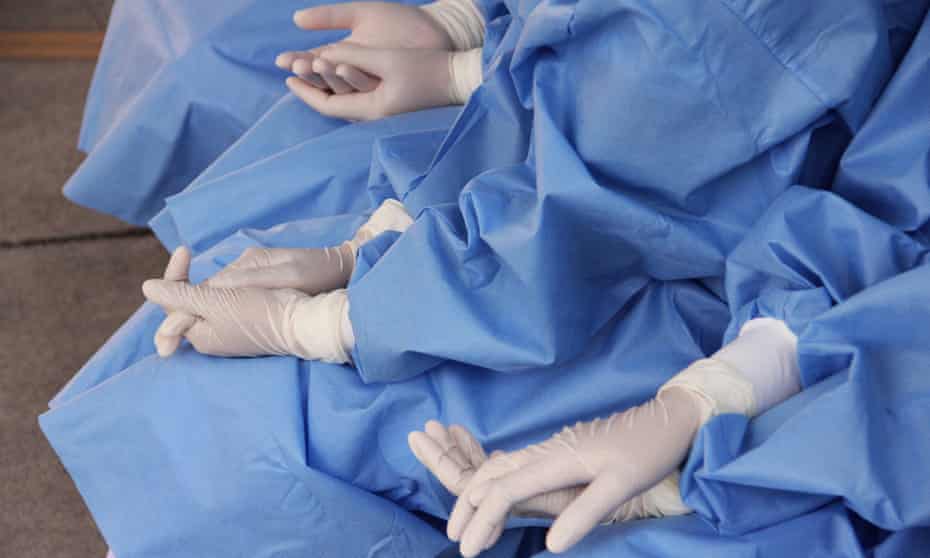Anger is mounting in Europe and elsewhere at renewed coronavirus restrictions brought in by governments in a bid to tackle another wave of infections.
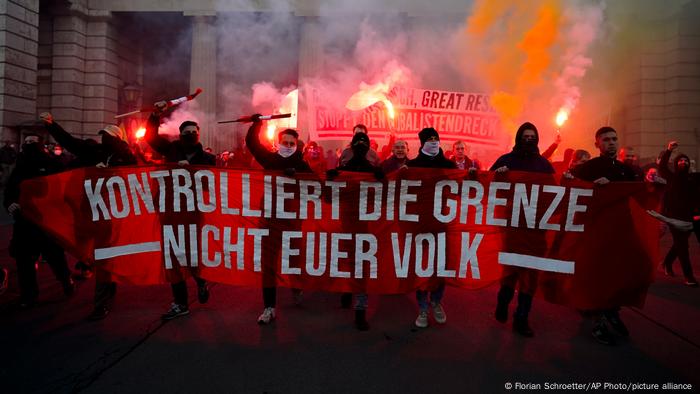
Far-right groups attended protests against coronavirus restrictions in Austria on Saturday
Thousands took to the streets across Europe and Australia on Saturday to protest fresh rounds of COVID restrictions.
Several countries have recently reintroduced tighter measures in a bid to combat a resurgent wave of infections.
Austria on Friday announced a nationwide partial lockdown — the most dramatic restrictions in Western Europe for months.
Other nations on the continent have resorted to less severe restrictions, often choosing to ban unvaccinated people from venues like restaurants and bars.
The Netherlands
In the Netherlands, rioters threw stones and fireworks at police, and set fire to bicycles as protests against coronavirus curbs turned violent for a second night in the country.
A day earlier, at least two people were injured after police fired shots at protesters and 51 were arrested at an anti-coronavirus restrictions demonstration in the city of Rotterdam.
Police arrested at least one person during a protest in The Hague.
Earlier in the day, several thousand protesters angered at the latest measures gathered in Amsterdam on Saturday. One group earlier in the day had cancelled their rally because of the previous night's violence.
In the southern city of Breda, near the Belgian border, a musical protest called by local DJs against current COVID-19 measures, which include the 8 p.m. (1900 UTC) closure of bars, restaurants and clubs, attracted a few hundred people.
The Netherlands went back into Western Europe's first partial lockdown of the winter last Saturday with at least three weeks of curbs. It is now planning to ban unvaccinated people from entering some venues.
Austria
Around 35,000 protesters, many from far-right groups, marched through the Austrian capital Vienna on Saturday.
Among those protesting were members of far-right and extreme-right parties and groups, including the far-right Freedom Party, the anti-vaccine MFG party and the extreme-right Identitarians.
Police said around 1,300 officers were on duty and several protesters were detained, but didn't give specific numbers.
From Monday, 8.9 million Austrians will not be allowed to leave home except to go to work, shop for essentials and exercise. The restrictions will initially last 20 days with an evaluation after 10 days.
The government is making vaccination against COVID-19 mandatory in the country from February 1 next year.
In Northern Ireland, several hundred people opposed to vaccine passports protested outside the city hall in Belfast.
The government of Northern Ireland voted this week to introduce vaccine certificates for admission to nightclubs, bars and restaurants starting December 13.
Some protesters carried signs that have been widely criticized as offensive, comparing coronavirus restrictions to the actions of Nazi Germany.
Croatia
In Croatia, thousands gathered in the capital of Zagreb. Some carried flags, nationalist and religious symbols, along with banners against vaccination and what they describe as restrictions of people's freedoms.
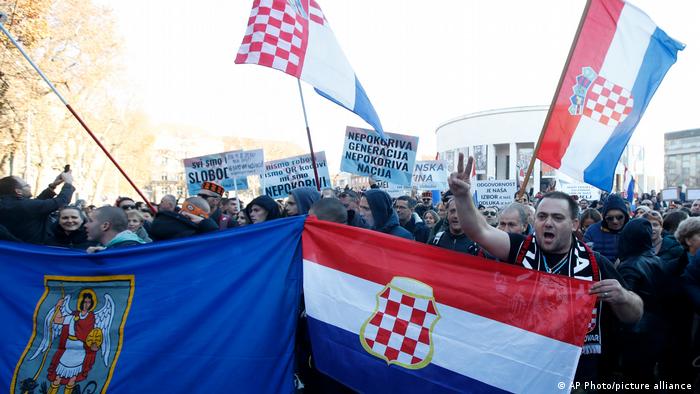
Thousands of protesters gathered in Croatia's capital Zagreb on Saturday
Italy
In Italy, 3,000 turned out in the capital's Circus Maximus to protest against "Green Pass" certificates, required at workplaces, restaurants, cinemas, theaters, sports venues and gyms, as well as for long-distance train, bus or ferry travel.
"People like us never give up," read one banner, in the red, white and green colors of the Italian flag. Almost no one wore a protective mask.
Australia
In Sydney, some 10,000 marched and there were protests in other major Australian cities against vaccine mandates applied to certain occupations by state authorities.
In Denmark, around one thousand people protested government plans to reinstate a COVID pass for civil servants going to work.
"Freedom for Denmark," cried some of the marchers at a rally organized by the radical Men in Black group who deny the existence of the virus.
Guadeloupe
France sent a group of dozens of elite security force officers to its overseas territory of Guadeloupe on Saturday after protests against coronavirus rules turned violent.
The deployment follows almost a week of unrest on the Caribbean island which included the burning of barricades in the street.
French Interior Minister Gerald Darmanin said around 50 agents from the GIGN counter-terrorism and RAID elite tactical forces would be sent to Guadeloupe.
Although almost 70% of the population of mainland France is already fully vaccinated, in Guadeloupe the share is less than 50%.

Police officers in riot gear charged the crowd backed by water cannon
Kenzo TRIBOUILLARD
Sun, November 21, 2021, 7:44 AM·2 min read
Violence broke out at a protest against anti-Covid measures in Brussels on Sunday, in which police said tens of thousands of people took part.
The march began peacefully but police later fired water cannon and tear gas in response to protesters throwing projectiles, an AFP photographer witnessed.
AFP also saw at least two police injured in the events, as officers in riot gear charged the crowd backed by water cannon. One protester was seen being evacuated by an ambulance near the Berlaymont, the EU headquarters.
Police told Belga news agency that three police officers were injured in the rioting, without giving further details.
Several of the demonstrators caught up in the clash wore hoods and carried Flemish nationalist flags, while others wore Nazi-era yellow stars.
Protesters set fire to wood pallets, and social media images showed rioters attacking police vans with vandalised street signs.
The stand-off with riot police took place throughout the Belgian capital's EU and government district, just metres (yards) from the US and Russian embassies.
Police said 42 people were briefly detained, while two were arrested. By 1700 GMT, authorities said the situation was under control with streets reopened.
Police said 35,000 protesters marched from the North Station in Brussels against a fresh round of Covid measures announced by the government on Wednesday.
The demonstration, called "Together for Freedom", largely focused on a ban on the unvaccinated from venues such as restaurants and bars.
Europe is battling another wave of infections and several countries have tightened curbs despite high levels of vaccination, especially in the west of the continent.
Belgium, one of the countries hit the hardest by the latest wave, on Wednesday expanded its work-from-home rules and strengthened curbs targeting the unvaccinated.
With an average of nearly 10,300 new infections per day over the past week, Belgium is back to a rate of spread of the virus that has not been seen for a year.
Belgium also recorded 42 Covid deaths on Friday.
bur-arp/gd

1 of 12
BRUSSELS (AP) — Ten of thousands of people demonstrated through central Brussels on Sunday to protest reinforced COVID-19 restrictions imposed by the Belgian government to counter the latest spike in coronavirus cases.
Many among the police estimate of 35,000 at the rally had already left for home when the demonstration descended into violence as several hundred people started pelting police, smashing cars and setting garbage bins ablaze. Police, responded with tear gas and water cannons and sought to restore order as dusk settled on the Belgian capital.
Three police officials and one demonstrator were injured in the clashes. In addition, 42 protesters were detained and two were arrested and charged in the violent spree that followed the march, said police spokesperson Ilse Vande Keere.
The marchers came to protest the government’s strong advice to get vaccinated and any possible moves to impose mandatory shots.
Shouting “Freedom! Freedom! Freedom!” and singing the anti-fascist song “Bella Ciao,” protesters lined up behind a huge banner saying “Together for Freedom” and marched to the European Union headquarters. Amid the crowd, the signs varied from far-right insignia to the rainbow flags of the LGBT community.
The World Health Organization said last week that Europe was the hot spot of the pandemic right now, the only region in which COVID-19 deaths were rising. The autumn surge of infections is overwhelming hospitals in many Central and Eastern European nations, including Ukraine, Russia, Romania, the Czech Republic and Slovakia.
Over the past several days, there have been many anti-vaccination marches in European nations as one government after another tightened measures. Dutch police arrested more than 30 people during unrest in The Hague and other towns in the Netherlands on Saturday, following much worse violence the previous night.
Austria is going into a 10-day national lockdown on Monday for everyone after first imposing a lockdown on the unvaccinated. Christmas markets in Vienna were packed Sunday with locals and tourists taking in the holiday sights before shops and food stalls are forced to close.
___
Follow AP coverage of the pandemic at https://apnews.com/hub/coronavirus-pandemic
Dutch police arrest dozens over new Covid riots


Dutch police arrest dozens over new Covid riotsThe two nights of unrest in a number of cities came a week after the Dutch government went into a partial lockdown over a surge in cases
Danny KEMP and Julie CAPELLE
Sun, November 21, 2021
Dutch police said Sunday they had arrested 48 people after a second night of violent riots erupted over the government's coronavirus measures.
Prosecutors meanwhile updated to four the number of people shot when police opened fire during an "orgy of violence" in the port city of Rotterdam on Friday night.
The two nights of unrest in a number of cities came a week after the Dutch government went into a partial lockdown over a surge in cases.
In The Hague on Saturday night, officers in riot gear charged demonstrators who set fire to bicycles and an electric moped piled in the middle of a busy intersection.
"The police were also pelted with heavy fireworks and stones thrown from roofs," police said in a statement, adding that water cannon was used to put out the fire.
"Officers made a total of 19 arrests for, among other things, insult."
Five police officers were injured during the unrest while a rock thrown by rioters smashed the window of a passing ambulance carrying a patient, police said.
Thirteen people were arrested in separate riots in the towns of Stein and Roermond in southern Limburg province after fireworks were thrown at officers, police said.
Police also made 16 arrests during clashes in the "Bible Belt" town of Urk, where vaccination rates are very low due to conservative Protestant beliefs, local media said, quoting police.
- 'Going wild' -
Municipal workers surveyed the damage in The Hague's working-class Schilderswijk district on Sunday including a security camera toppled by the rioters and a patch of burned road where the pile of bikes was torched.
Local residents blamed the riots on frustrated youths and uncertainty over whether the government will introduce so-called "2G measures" that would let cafes and bars decide whether to turn away the unvaccinated.
"They don't know (if 2G will be introduced) and so they don't know what to do... They think that is the way to make themselves heard," Mustafa Toprak, 31, told AFP.
"It's a bad way to do it, but hey it's the young people who are going wild."
"They are young people and they have had few freedoms because of Covid-19 for almost two years now so yes I understand somehow -- only I can't approve," said Claudia van der Wijngaard, 60.
"No, I don't really see a solution as long as the government continues to work with sanitary measures, I don't see a solution coming and I'm afraid there will be more (riots)."

- 'Hit by bullets' -
On Friday violence broke out in the port city of Rotterdam after a protest against Covid measures, during which police opened fire and 51 suspects were arrested.
"It now appears that four people have been hit by bullets," the Dutch public prosecutor's office said in a statement, blaming medical confidentiality rules for the delay in getting the correct figure.
Police had previously said three people were wounded by gunshots and were being treated in hospital.
Some of the Rotterdam rioters had links to football hooligans and "groups that often have ties to other forms of organised crime," Justice and Security Minister Ferd Grapperhaus told public broadcaster NPO.
The Netherlands went back into western Europe's first partial lockdown of the winter last Saturday with at least three weeks of curbs under which bars, cafes, restaurants, supermarkets and non-essential shops must shut early.
The government has said it wants to bring in the 2G option -- which would bar unvaccinated people from getting Covid passes for some venues -- after that, but there has been opposition in parliament.
In January the Netherlands suffered its worst riots in decades after the government introduced a coronavirus curfew.
jcp-dk/gd
By MIKE CORDER

1 of 6
EDE, Netherlands (AP) — Dutch police have arrested more than 30 people during unrest in The Hague and other towns in the Netherlands that followed an “ orgy of violence ” the previous night at a protest against coronavirus restrictions.
The violence by groups of youths in The Hague and elsewhere Saturday night wasn’t as serious as Friday night in Rotterdam, where police opened fire on rampaging rioters and arrested 51 people.
Police said Sunday that they arrested 19 people in The Hague and used a water cannon to extinguish a fire on a street.
Two soccer matches in the country’s top professional league were briefly halted when fans — banned from matches under a partial lockdown in force in the Netherlands for a week — broke into stadiums in the towns of Alkmaar and Almelo.
In The Hague, police said five officers were injured as they tried to break up unrest by a group of youths who set at least two fires on streets and threw fireworks. Police said in a tweet that one rioter threw a rock at an ambulance carrying a patient to a hospital.
In the southern towns of Roermond and Stein, police said they arrested a total of 13 people for setting fires and throwing fireworks, and in the fishing village of Urk police arrested eight people for public order offenses, Dutch broadcaster NOS reported.
Earlier Saturday, two protests against COVID-19 measures proceeded peacefully in Amsterdam and the southern city of Breda. Thousands of people marched through Amsterdam to protest COVID-19 restrictions.
Tens of thousands of protesters also took to the streets of Vienna on Saturday after the Austrian government announced a nationwide lockdown beginning Monday to contain skyrocketing coronavirus infections.
There were also demonstrations in Italy, Switzerland, Croatia and Northern Ireland.
Police in Rotterdam said that three rioters were hit by bullets and investigations were underway to establish if they were shot by police on Friday night. The condition of the injured rioters wasn’t disclosed.
Officers in Rotterdam arrested 51 people, about half of them minors, police said Saturday afternoon. One police officer was hospitalized with a leg injury sustained in the rioting, another was treated by ambulance staff and “countless” others suffered minor injuries.
Rotterdam Mayor Ahmed Aboutaleb called the rioting in his city an “orgy of violence” and said that “on a number of occasions the police felt it necessary to draw their weapons to defend themselves.”
‘I lost everything’: Guadeloupe riots overtake COVID protest
BY ELODIE SOUPAMA AND SYLVIE CORBET

1 of 10
Emilie holds her burned passport in her charred home following riots in Pointe-a-Pitre, Guadeloupe island, Sunday, Nov.21, 2021. French authorities are sending police special forces to the Caribbean island of Guadeloupe, an overseas territory of France, as protests over COVID-19 restrictions erupted into rioting. In Pointe-a-Pitre, the island's largest urban area, clashes left three people injured, including a 80-year-old woman who was hit by a bullet while on her balcony. A firefighter and a police officer were also injured and several shops were looted there and in other towns. (AP Photo/Elodie Soupama)
LE GOSIER, Guadeloupe (AP) — Residents in the Caribbean island of Guadeloupe, an overseas territory of France, expressed dismay Sunday after protests against COVID-19 restrictions erupted into rioting and looting for the third day in a row, prompting French authorities to send in police special forces.
Road blockades by protesters made traveling across the island nearly impossible Sunday. Firefighters reported 48 interventions overnight into Sunday morning. The island of 400,000 people has one of the lowest vaccination rates in France at 33%, compared with 75% across the country.
In Pointe-a-Pitre, the island’s largest urban area, clashes left three people injured, including a 80-year-old woman hit by a bullet while on her balcony. A firefighter and a police officer were also injured and several shops were looted there and in other towns. A police station in Morne-à-l’Eau was set on fire.
Guadeloupe Prefect Alexandre Rochatte, who has imposed a nightly curfew from 6 p.m. to 5 a.m., said Sunday that 38 people were arrested overnight and denounced the “organized groups now seeking to sow chaos.”
Emilie Guisbert, a 47-year-old Pointe-a-Pitre resident, was sleeping in her home in the building owned by her father when it was set on fire on Thursday evening. Her friend woke her up and she just had time to dress and run out with her dogs, she told The Associated Press.
“I lost everything. Everything. I went out with my cellphone and what I was wearing,” she said, adding that personal belongings of her parents, grandparents and great-grandparents were in the house. “It’s 100 years of memory of a Guadeloupean family that went up in smoke in 15 minutes.”
She said she did not receive help from authorities yet. “We are completely left to ourselves. I don’t know who is clearing (the house). Is it us, the insurance, the city hall?”
The protests were called for by unions to denounce France’s COVID-19 health pass, which is required to access restaurants and cafes, cultural venues, sport arenas and long-distance travel. Demonstrators were also protesting France’s mandatory vaccinations for health care workers. In recent days, they broadened their demands to include a general salary increase, higher unemployment benefits and the hiring of more teachers.
Gregory Agapé, 30, who also lives in a Pointe-à-Pitre neighborhood where violence has repeatedly taken place, said he cannot sleep at night.
“We are always upset by the noises, bangs, all the bustle around so nights are very complicated, very short,” he said.
Agapé said he has contradictory thoughts about the COVID-19 protest movement. “I’m well aware of economic, social, cultural difficulties ... but its quite complicated, because I think (the protests) are making Guadeloupean society even more fragile.”
Jacques Bertili, a 49-year-old Le Gosier resident, said “I’m not against nor for the vaccine. But what makes me upset is looting. Because we need to work.”
French Interior Minister Gerald Darmanin denounced the violence as “unacceptable” in an interview Sunday with Le Parisien newspaper. He said 50 officers from police special forces were arriving Sunday in Guadeloupe, in addition to 200 other police sent earlier.
Darmanin said following an emergency meeting Saturday in Paris that “some shots have been fired against police officers” in Guadeloupe. He also said road blockades created a “very difficult situation for a few hours” during which patients and supplies couldn’t reach hospitals.
Rochatte said some electrical facilities near dams have been damaged, which has caused some power outages, and urged people not to go near downed electrical cables.
___
Follow AP coverage of the pandemic at https://apnews.com/hub/coronavirus-pandemic
